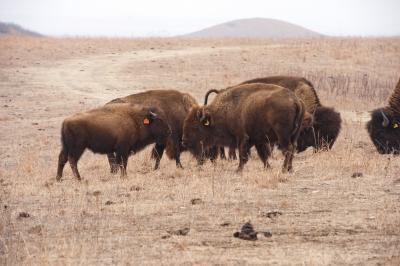An assistant professor in the Division of Biology at Kansas State University is projecting that grazing animals such as bison and cattle will get smaller due to global warming in the Great Plains.
The conclusion came about by comparing bison in cooler, wetter regions with those in warmer, drier regions. For example, the average 7-year-old male bison in South Dakota weighed 1,900 pounds, while an average 7-year-old male bison in Oklahoma -- a warmer region -- weighed 1,300 pounds. The cause: grasses in the southern Great Plains have less protein than grasses in the northern Great Plains because of the warmer climate.
The biologist analyzed a data set of 290,000 weights, ages and sexes collected from 22 bison herds throughout the U.S. The information came from herds owned by the university's Konza Prairie Biological Station; Oklahoma's Nature Conservancy; Turner Enterprises; and other federal, state, nonprofit and commercial entities. The organizations kept annual records of each animal in the herd and matched the data with the climates of the sites.
"Bison are one of our most important conservation animals and hold a unique role in grasslands in North America," said professor Joseph Craine. "In addition to their cultural and ecological significance, they're economically important both from a livestock perspective and from a tourism perspective. There are about half a million bison in the world."
Based on differences in sizes of bison across herds, Craine found that during the next 50 years, future generations of bison will be smaller in size and weigh less. Climate is likely to reduce the nutritional quality of grasses, causing the animals to grow more slowly.
"We know that temperatures are going to go up," Craine said. "We also know that warmer grasslands have grasses with less protein, and we now know that warmer grasslands have smaller grazers. It all lines up to suggest that climate change will cause grasses to have less protein and cause grazers to gain less weight in the future."

Bison roam the grasslands of the Konza Prairie Biological Station. Credit: Kansas State University Photo Services
"The difference in temperature between those two states is around 20 degrees Fahrenheit, which is about three times the projected increase in temperatures over the next 75 years," Craine said. "That's a pretty extreme difference and beyond the worst-case scenario. But it is a clear indicator that long-term warming will affect bison and is something that will happen across the U.S. over the next 50-75 years."
While the economic cost of smaller bison might not be so great, Craine said that warming might also shrink the revenue of cattle producers.
Although compiling and analyzing data about cattle weights has yet to be done, findings for bison may translate to the more than 90 million cattle in the U.S., Craine said. Cattle and bison share similar physiologies and weight gain for both is typically limited by protein intake.
If the same reduction in weight gain applies to cattle as bison, every temperature increase of one-and-a-half degrees Fahrenheit could cause roughly $1 billion in lost income for cattle producers, Craine said. The reduction would come from either the cost of protein supplements needed to maintain similar weight gains before climate change, or from a loss of income because of reduced weights. Scientists predict that temperatures in the U.S. will increase by 6-8 degrees Fahrenheit during the next 75 years.
The study is an offshoot of Craine's ecology research with the Konza Prairie Biological Station, which is jointly owned by The Nature Conservancy and Kansas State University. Managed by the university's Division of Biology, the Konza Prairie spans about 8,600 acres.
The study, "Long-term climate sensitivity of grazer performance: a cross-site study," was recently published in editorially reviewed journal PLoS ONE.






Comments